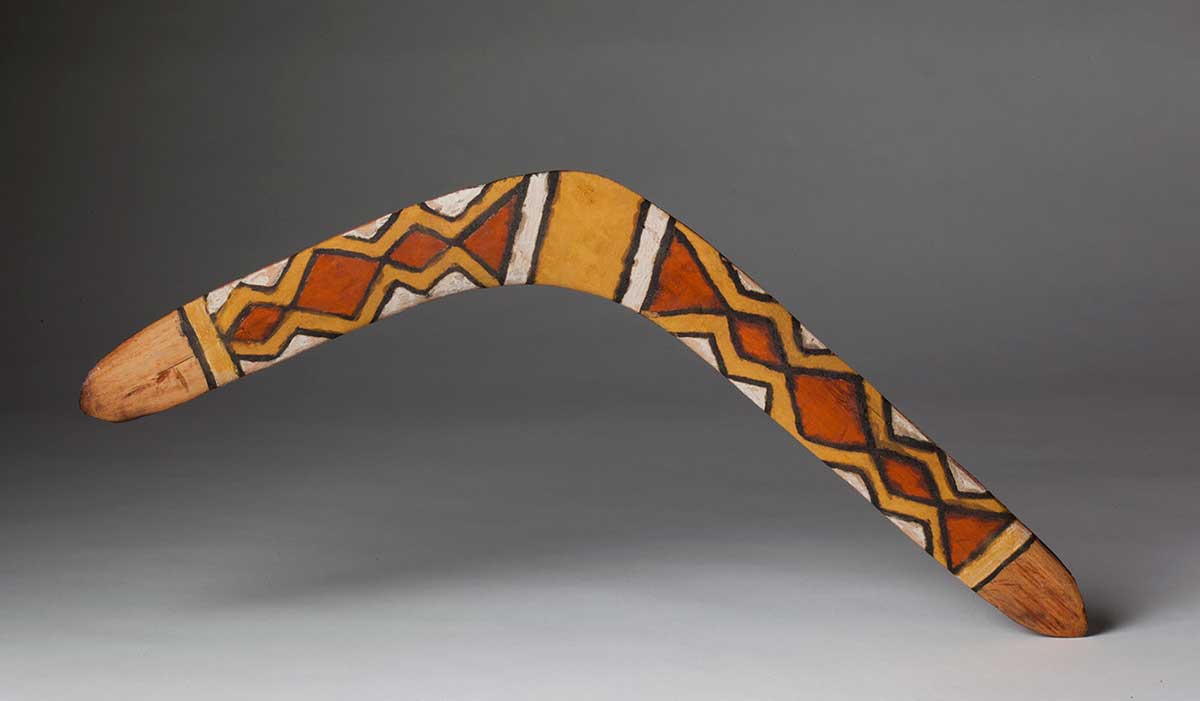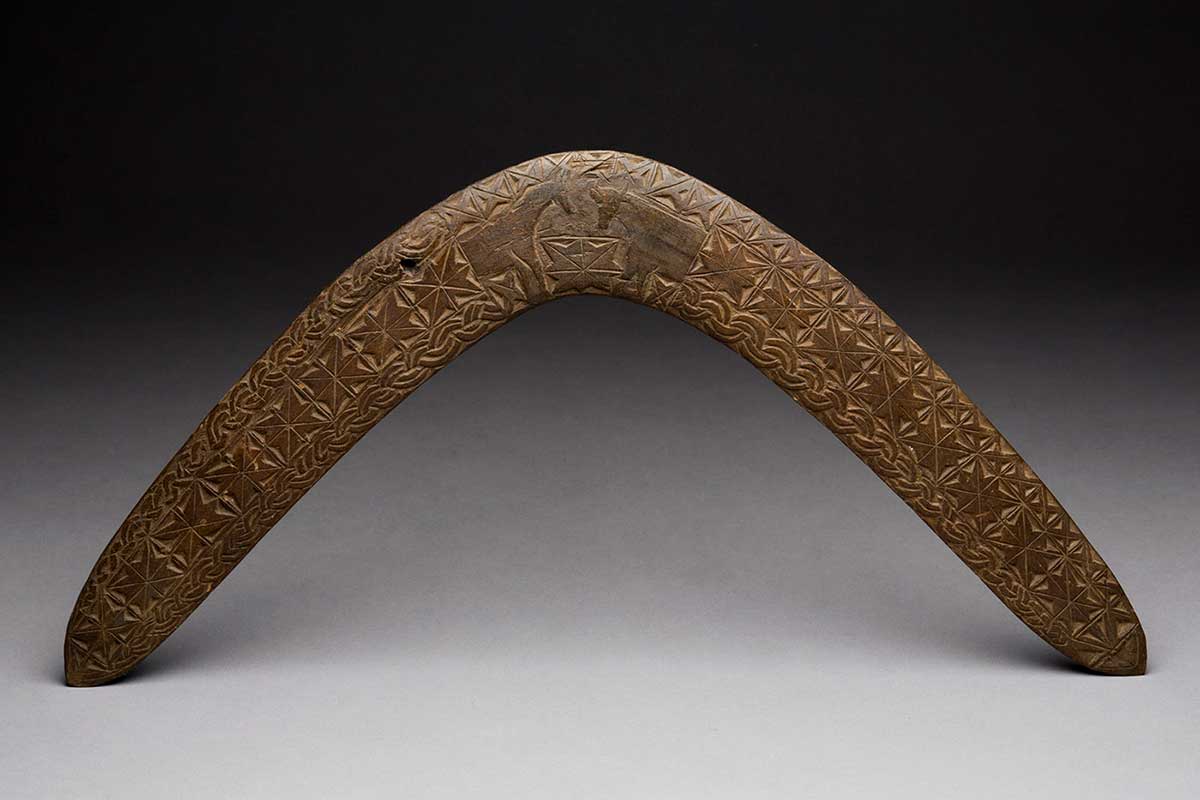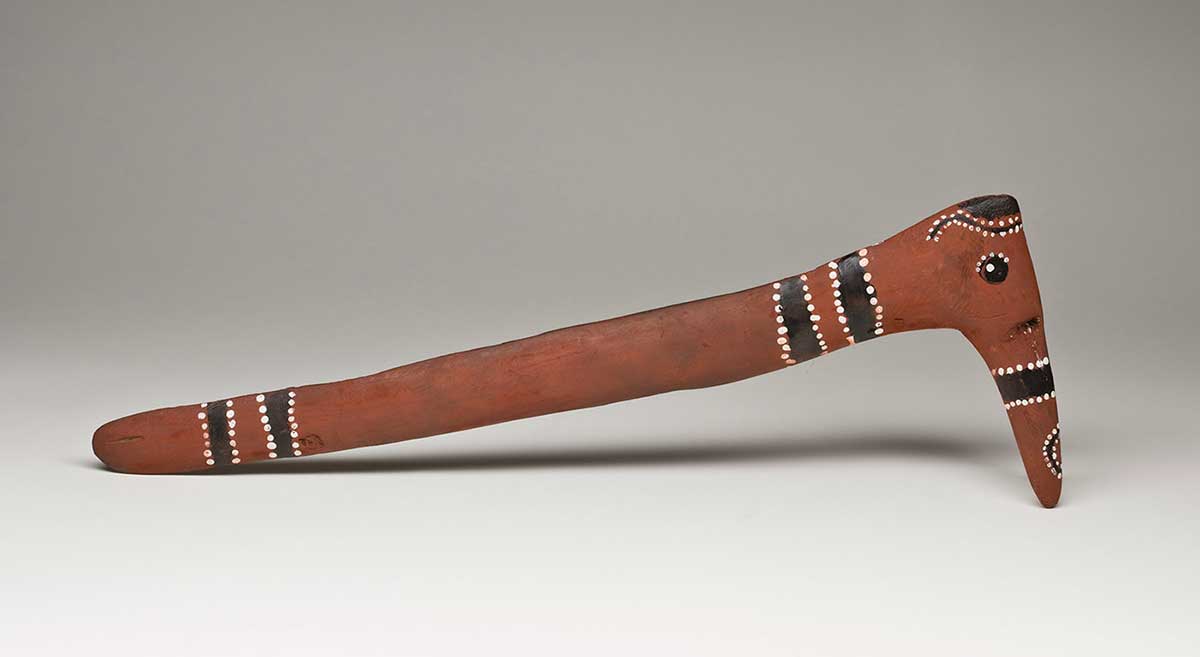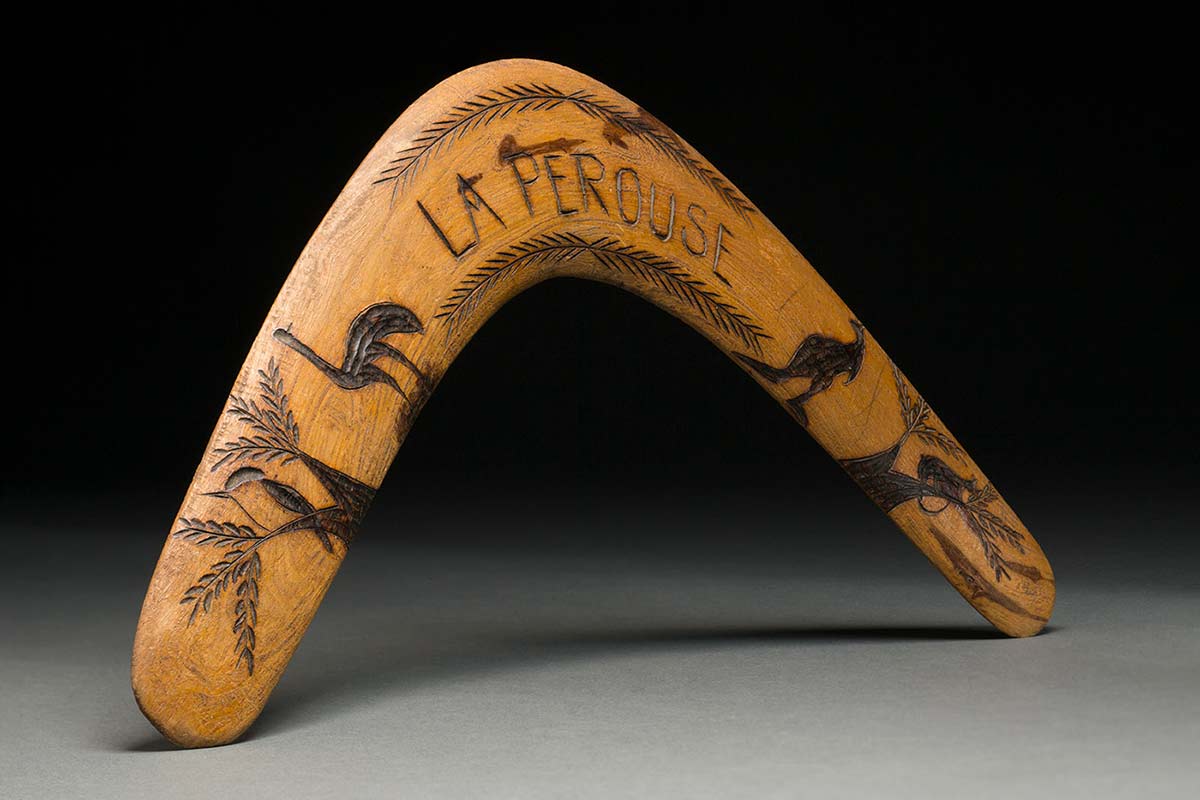Boomerangs are an internationally recognised symbol of Australia. For Aboriginal people the boomerang is a symbol of cultural endurance and a tangible link to their long presence on this continent.
The boomerang features in Aboriginal creation mythology, and for Aboriginal people the boomerang is considered as old as the continent.
Paddy Japaljarri Sims, Warlpiri elder, on the Purlka-purlkakurlu – Old Men Dreaming:
The Old Men carved their boomerangs in preparation for battle. They were Dreamtime Men and they sat carving boomerangs so that they could go and attack other Old Men.
Boomerangs and creation myths
Aboriginal creation myths recount how the Ancestors formed the landscape of Australia.
The Dreaming extends from the past into the present. In the Dreaming many significant features – rivers, rock formations and mountains – were created when Ancestors threw boomerangs and spears into the earth.
For Aboriginal people the boomerang is as old as creation and a symbol of the enduring strength of Aboriginal culture.
Boomerangs across Australia
With more than 250 different language groups it is understandable that boomerang-making varies across the continent. Larger, heavier boomerangs are used by inland and desert people; lighter boomerangs are thrown by coastal and high-country people. The vast majority of boomerangs are of the non-returning variety.
Carving and colouring of boomerangs differs across the continent; the styles of decoration are as varied as the individual makers.
Boomerang uses
Boomerangs have many uses. They are weapons for hunting birds and game, such as emu, kangaroo and other marsupials. The hunter can throw the boomerang directly at the animal or make it ricochet off the ground. In skilled hands, the boomerang is effective for hunting prey up to 100 metres away.
When hunting for birds, either returning or non-returning boomerangs can be used. A returning boomerang can be thrown above a flock of ducks to simulate a hovering hawk. The frightened birds then fly into nets set up in their flight path or, if they come within range, the hunters can use non-returning boomerangs to bring the birds down.
Boomerangs can be used to kill fish in areas of high tidal variation where fish are trapped in beach or rock pools. Designed to slice through water, these boomerangs are heavier and have none of the aerodynamic qualities of flying boomerangs.
Boomerangs are fighting weapons. Thrown at each other by combatants, medium-weight boomerangs are a deadly weapon, but for close quarter skirmishing, large boomerangs up to two metres tall can be used as fighting sticks.
Boomerangs can be used as a digging stick when foraging for root vegetables or for scraping ashes away from a fire. They can also be used to make fire; the sharp edge of a boomerang when rubbed along a softwood surface creates enough heat to generate a spark that can ignite grass.
Finally, boomerangs feature prominently in Aboriginal dance and music, as a percussion instrument when a pair are rattled together, and as an accessory to ceremonial dance.
Boomerang-makers can ‘tune’ their boomerangs to serve many of these different uses and different environmental conditions by reshaping the boomerang’s wings.
Boomerangs and throwing sticks
Australia was not the only place in the world where throwing sticks like the boomerang developed. A 23,000-year-old mammoth tusk carved in a shape similar to the boomerang was discovered in Poland in 1986.
The oldest Australian boomerangs yet discovered were found in Wyrie Swamp, South Australia, in 1973 and have been dated to about 10,000 years ago.
However, the oldest images of boomerangs in Australia are found among the Bradshaw/Gwion Gwion rock art paintings in the Kimberley, and are about 20,000 years old.
Boomerang construction
Shayne Williams, La Perouse, 2014:
So people would, you know, be patient, they would take the boomerang knee or elbow from the tree, get the shape they want, dry it out in the shade, and then, you know, they could sit there for a few weeks or so before it’s dried properly, and then they would actually use bits of glass and spend days and days just scraping it back, till you've got this really smooth shape here on the face of it, and on the back as well.
And people didn't rush either, they took their time, you know, they had pride in what they was doing and they wasn't in a great hurry. And because this was all done by hand, you'll always get each item quite different to the next one, because they're not mass produced like from factories … they've been done by hand, actually unique. And I think that is what probably makes these things special …
Boomerang trade
For many thousands of years, Aboriginal groups exchanged boomerangs across the continent.
Two specific types were traded extensively. Hooked, or ‘number 7’, boomerangs from north central Australia were exchanged across a large area from the Kimberley east to what is now Queensland and south to the MacDonnell Ranges. Heavy, carved boomerangs made by people in the Darling and Cooper river systems were traded widely to the east and west.
Trade in boomerangs continued after 1788. European fascination with the boomerang, especially the returning variety, meant that early barter with settlers, and then tourists, led Aboriginal people to create a cottage industry making boomerangs. That trade continues today.
The boomerang as a Defining Moment
The boomerang has become an internationally recognised symbol of Australia. In the process it has contributed to the cultural diversity of distinct Aboriginal nations being replaced in the popular imagination by a more homogenised identity.
In popular understanding, Aboriginal people are all believed to use the same style of returning boomerang and that symbol has been appropriated by airlines, taxi companies and travel agents to suggest they will return their clients safely home.
Boomerangs have become mass-produced souvenirs, a typical gift to visiting dignitaries and royalty, hi-tech sports objects and kitsch symbols of Australia.
Through this all, boomerangs have endured. They are still made in Aboriginal communities and, although rarely used now for hunting and fishing, are a tangible link to Aboriginal history and country.
In our collection
Explore Defining Moments
References
Philip Jones, Boomerang, Ten Speed Press, Berkeley, California, 1996.
Lorin Lindley Hawes, All About Boomerangs, Hamlyn, Sydney, 1975.
Benjamin Ruhe, Many Happy Returns: The Art and Sport of Boomeranging, Viking Press, New York, 1977.



